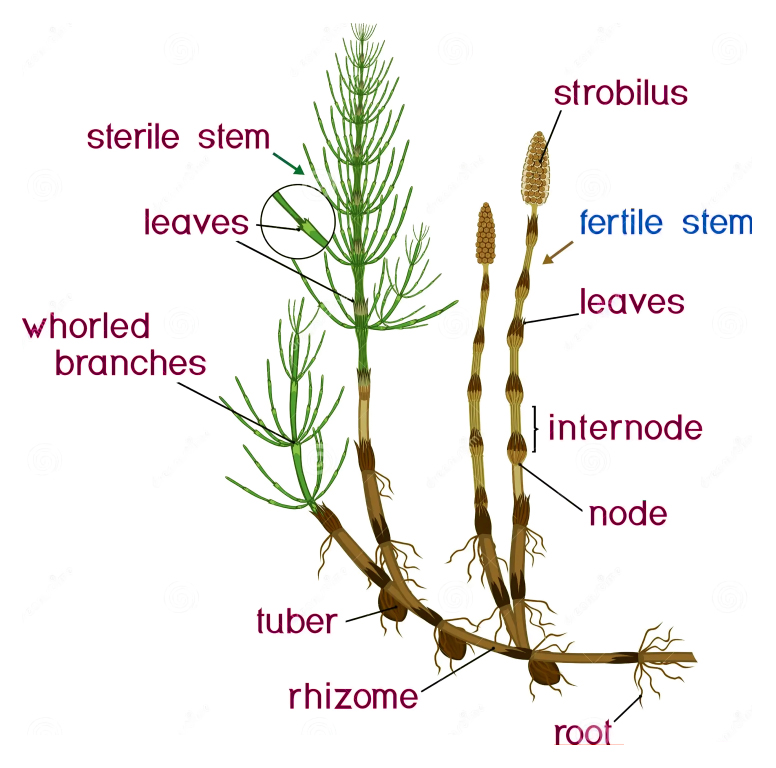
Equisetum: In the plant kingdom, equisetum is most closely related to ferns. Like ferns, equisetum does not produce seeds but reproduces sexually through spores. However, spores play a minor role in the spread of equisetum. Instead, equisetum primarily spreads through an extensive underground rhizome system that can reach depths of over four feet. Equisetum patches expand outward as these rhizomes grow from the center. Without soil disturbances that move rhizome pieces, the lateral spread of horsetail is relatively slow about 20 inches per growing season. Detailed NEET Biology Notes on equisetum, including diagrams, life cycle, reproduction, and classification, are provided in the article below.
NEET Previous Year Question Papers
What is Equisetum?
The Equisetaceae family includes a single genus, Equisetum, which has about 15 species worldwide. In Iowa, the most common species are Equisetum hyemale (scouring rush) and Equisetum arvense (field horsetail). In botany, Equisetum is closely related to ferns. Similar to ferns, Equisetum does not produce seeds but reproduces sexually through spore formation. However, spores are not as crucial in the spread of Equisetum. Instead, Equisetum spreads primarily through an extensive underground rhizome system that can extend over 4 feet. These patches grow outward from the center as the rhizomes expand. The lateral spread of horsetail is slower in undisturbed soil, which inhibits the movement of rhizome pieces.Sexual Reproduction in Flowering Plants
Equisetum Diagram
Equisetum Diagram is as follows:

Equisetum Classification
Equisetum, commonly known as horsetail, is the only living genus in the family Equisetaceae. These ancient herbaceous plants reproduce via spores and belong to the division Pteridophyta. They are considered “living fossils” and have a long evolutionary history. The detailed Equisetum classification is as follows:| Equisetum Classification | |
|---|---|
| Taxonomic Rank | Classification |
| Kingdom | Plantae |
| Class | Polypodiopsida |
| Order | Equisetales |
| Family | Equisetaceae |
| Genus | Equisetum |
Structural Organisation in Animals
Equisetum Structure
Equisetum, commonly referred to as horsetails, are ancient plants that do not produce flowers. They belong to the genus Equisetum within the Equisetophyta division. These plants are distinct in their structure compared to most other plant species. The morphological structure of equisetum is as follows Stems: Equisetum plants are mainly composed of segmented stems. These stems are hollow and have deposits of silica, which give them a rough texture. They emerge from underground rhizomes and typically have a cylindrical shape with clear nodes and internodes. Nodes and Internodes: Nodes are points along the stem where leaves or branches are connected. In Equisetum, nodes are identified by clusters of small, scale-like leaves that form a sheath around the stem. Internodes are the sections between two nodes. Leaves (Microphylls): Equisetum does not possess true leaves. Instead, it features tiny, scale-like structures called microphylls, which are fused into sheaths at each node. These microphylls are arranged in circular patterns around the stem. Reproductive Structures: Equisetum reproduces through spores rather than seeds. Spore-producing structures are found on cone-shaped formations called strobili (singular: strobilus) that develop at the tips of some stems. Roots: Equisetum plants have adventitious roots that grow from nodes on the underground rhizomes. These roots serve to anchor the plant in the soil and absorb water and nutrients.Equisetum Charcteristics
Equisetum is a distinct group of plants with important evolutionary implications. The following are some key characteristics of these plants:- Stems and Leaves: Equisetum stems are hollow, segmented, and ridged. They do not have true leaves but possess small, scale-like structures known as "microphylls" that are arranged in circles around the stem joints.
- Reproduction: Equisetum reproduces through spores that are produced in cone-shaped structures called "strobili." These strobili are located at the tips of the fertile stems.
- Silica Deposits: The stems contain abrasive silicates, making them useful for polishing and cleaning. These silicates also give the stems a rough texture.
- Ecology: Horsetails thrive in wet environments such as marshes, riverbanks, and damp woodlands. Some species can tolerate drier conditions, while others prefer aquatic habitats.
- Evolutionary Significance: Equisetum represents an ancient plant lineage, with origins tracing back to the Paleozoic era. During the Carboniferous period, large tree-like horsetails were prevalent in terrestrial ecosystems.
- Medicinal Uses: Traditionally, Equisetum has been used for various medicinal purposes, including wound healing and as a diuretic. However, there is limited scientific evidence to support its medicinal properties.
| Important NEET Biology Notes | ||
|---|---|---|
| Selaginella | Embryo | Malvaceae |
| Pinus | Polyembryony | Volvox |
Equisetum is Homosporous or Heterosporous
Equisetum is homosporous, meaning it produces a single type of spore that matures into a gametophyte possessing both male and female reproductive structures. This bisexual gametophyte generates both male and female gametes. In contrast, heterosporous plants like some ferns produce two distinct types of spores: microspores develop into male gametophytes, while megaspores develop into female gametophytes.Equisetum Reproduction
Equisetum, known as horsetail, uses two main methods for reproduction: sexual spore production and asexual vegetative spread. Let's explore each process in detail:1. Spore Production: Sexual Reproduction
This method involves a complex alternation of generations between a dominant plant form called sporophyte (which we recognize as the Equisetum plant) and a free-living gametophyte. Formation of Spores:- Strobili (Cones): Specialized fertile shoots, often without chlorophyll, produce cones (strobili) at their tips.
- Sporangia: Inside these cones are small sacs called sporangia. These undergo meiosis, a type of cell division that halves the chromosome count, forming haploid spores (with half the usual number of chromosomes).
- Release of Spores: When mature, sporangia open up, releasing a cloud of haploid spores into the air. These spores are essential for sexual reproduction.
- Germination of Spores: If a spore lands in a moist environment, it germinates and develops into a tiny, independent gametophyte.
- Independent Phase: Unlike the sporophyte, the gametophyte lives independently and can perform photosynthesis. It usually appears inconspicuous, resembling a flat green structure (thallus).
- Sexual Organs: The gametophyte forms specialized sex organs known as antheridia (which produce sperm) and archegonia (which produce eggs).
- Need for Water: Water is crucial for fertilization. Sperm released by one gametophyte swims through water to reach and fertilize an egg on another gametophyte.
- Formation of Zygote: The fertilized egg develops into a diploid zygote (with a full set of chromosomes). This zygote grows into the initial cell of the next generation sporophyte.
- Development of Sporophyte: Initially relying on the gametophyte for nutrition, the young sporophyte eventually becomes independent, developing its own ability to perform photosynthesis. This sporophyte phase dominates the life cycle of Equisetum, persisting for many years.
| Important NEET Biology Notes | ||
|---|---|---|
| Chara | Funaria | Apomixis |
| Rhizopus | Spirogyra | Bacteriophage |
2. Vegetative Reproduction: Asexual Spread via Rhizomes
Equisetum is highly proficient in asexual reproduction through its extensive network of underground rhizomes.- Rhizomes: These are modified, horizontal underground stems that store carbohydrates. Similar to above-ground stems, they have nodes and internodes and can grow several meters long and deep.
- Fragmentation: Rhizomes can naturally break apart or be fragmented by disturbances. Each fragment containing a node and bud has the potential to develop into a new Equisetum plant.
- Rapid Expansion: This method allows Equisetum to spread rapidly and efficiently, forming large colonies that are challenging to remove.
Equisetum Life Cycle
Equisetum, commonly known as horsetails, undergoes a unique life cycle that includes two distinct phases: a dominant sporophyte and a short-lived gametophyte.Sporophyte (Dominant Generation)
The sporophyte is the tall, green, leafy plant visible to us. It plays a crucial role in spore production and photosynthesis. The sporophyte has an advanced vascular system that transports water and nutrients throughout the plant. Spores are created in structures called strobili, found at the ends of some stems. Within these strobili, sporangia undergo meiosis to generate haploid spores. Spores: Spores are individual reproductive units enclosed in a tough outer coat. They are dispersed by the wind and can germinate when conditions are moist.Gametophyte (Independent Generation)
Spores germinate to produce tiny, independent gametophytes. The gametophyte is a small, flat, green structure resembling a heart-shaped thallus. It is inconspicuous and has a brief lifespan. The gametophyte generates sperm (antheridia) and eggs (archegonia) through mitosis.Fertilization
Sperm cells from the antheridia move through a film of water to reach the archegonia. Fertilization happens when a sperm cell merges with an egg cell, forming a diploid zygote.Development of Sporophyte
The zygote grows into a new sporophyte. Initially, the sporophyte relies on the gametophyte for nourishment, but eventually becomes self-sufficient. As the sporophyte matures, the gametophyte diminishes and eventually disappears. Equisetum follows an alternation of generations life cycle, with a dominant sporophyte and a short-lived gametophyte. Spores are created by meiosis within the sporophyte and develop into gametophytes. Gametophytes produce sperm and eggs, which fuse to create a zygote. This zygote then matures into a new sporophyte generation. Physics Wallah provides a wide range of NEET online courses to cater to all aspirants. Our best Online NEET Coaching classes provide a variety of options, such as free batches, online NEET preparation for classes 11 and 12, and NEET Online Coaching for Dropouts. These courses are designed to help students prepare for the NEET exam and are distinguished by our experienced faculty.Equisetum FAQs
Q 1. Is Equisetum classified as a Pteridophyte?
Q 2. What are the characteristics of Equisetum?
Q 3. What is Equisetum used for?
Q 4. Is Equisetum heterosporous?
Q 5. What is the life cycle of Equisetum?










